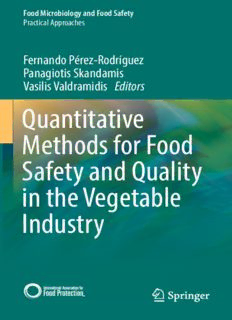
Quantitative Methods for Food Safety and Quality in the Vegetable Industry PDF
Preview Quantitative Methods for Food Safety and Quality in the Vegetable Industry
Food Microbiology and Food Safety Practical Approaches Fernando Pérez-Rodríguez Panagiotis Skandamis Vasilis Valdramidis Editors Quantitative Methods for Food Safety and Quality in the Vegetable Industry Food Microbiology and Food Safety Practical Approaches SeriesEditor: MichaelP.Doyle Food Microbiology and Food Safety Series TheFoodMicrobiologyandFoodSafetyseriesispublishedinconjunctionwiththe International Association for Food Protection, a non-profit association for food safety professionals. Dedicated to the life-long educational needs of its Members, IAFP provides an information network through its two scientific journals (Food ProtectionTrendsandJournalofFoodProtection),itseducationalAnnualMeeting, international meetings and symposia, and interaction between food safety professionals. Series Editor Michael P. Doyle, Regents Professor and Director of the Center for Food Safety, UniversityofGeorgia,Griffith,GA,USA Editorial Board Francis F. Busta, Director, National Center for Food Protection and Defense, UniversityofMinnesota,Minneapolis,MN,USA PatriciaDesmarchelier,FoodSafetyConsultant,Brisbane,Australia JeffreyFarber,FoodScience,UniversityofGuelph,ON,Canada VijayJuneja,SupervisoryLeadScientist,USDA-ARS,Philadelphia,PA,USA ManpreetSingh,DepartmentofFoodSciences,PurdueUniversity,WestLafayette, IN,USA RuthPetran,VicePresidentofFoodSafetyandPubicHealth,Ecolab,Eagan,MN, USA Elliot Ryser, Department of Food Science and Human Nutrition, Michigan State University,EastLansing,MI,USA Moreinformationaboutthisseriesathttp://www.springer.com/series/7131 Fernando Pe´rez-Rodr´ıguez • Panagiotis Skandamis • Vasilis Valdramidis Editors Quantitative Methods for Food Safety and Quality in the Vegetable Industry Editors FernandoPe´rez-Rodr´ıguez PanagiotisSkandamis DepartmentofFoodScience FoodScienceandHumanNutrition andTechnology AgriculturalUniversityofAthens InternationalCampusofExcellence Athens,Greece intheAgriFoodSector(CeiA3) UniversityofCordoba Co´rdoba,Spain VasilisValdramidis FoodSciencesandNutrition UniversityofMalta Msida,Malta FoodMicrobiologyandFoodSafety PracticalApproaches ISBN978-3-319-68175-7 ISBN978-3-319-68177-1 (eBook) https://doi.org/10.1007/978-3-319-68177-1 LibraryofCongressControlNumber:2018930239 ©SpringerInternationalPublishingAG2018 Thisworkissubjecttocopyright.AllrightsarereservedbythePublisher,whetherthewholeorpartof the material is concerned, specifically the rights of translation, reprinting, reuse of illustrations, recitation, broadcasting, reproduction on microfilms or in any other physical way, and transmission or information storage and retrieval, electronic adaptation, computer software, or by similar or dissimilarmethodologynowknownorhereafterdeveloped. The use of general descriptive names, registered names, trademarks, service marks, etc. in this publicationdoesnotimply,evenintheabsenceofaspecificstatement,thatsuchnamesareexempt fromtherelevantprotectivelawsandregulationsandthereforefreeforgeneraluse. Thepublisher,theauthorsandtheeditorsaresafetoassumethattheadviceandinformationinthis book are believed to be true and accurate at the date of publication. Neither the publisher nor the authors or the editors give a warranty, express or implied, with respect to the material contained hereinor for anyerrors oromissionsthat may havebeenmade. Thepublisher remainsneutralwith regardtojurisdictionalclaimsinpublishedmapsandinstitutionalaffiliations. Printedonacid-freepaper ThisSpringerimprintispublishedbySpringerNature TheregisteredcompanyisSpringerInternationalPublishingAG Theregisteredcompanyaddressis:Gewerbestrasse11,6330Cham,Switzerland Dedicated to Little Mary, Clara, and Ioanna Contents QuantitativeMethodsforFoodSafetyandQuality intheVegetableIndustry........................................................ 1 FernandoPe´rez-Rodr´ıguez,PanagiotisSkandamis, andVasilisValdramidis QualityandSafetyManagementSystemsintheProduction ofVegetables....................................................................... 11 SofiaG.Cuggino,AlejandraPe´rezAgostini,SandraKopp, andRicardoNovo RelevantPathogenicandSpoilageMicroorganismsinVegetable Products............................................................................ 29 AbaniK.Pradhan,AbhinavMishra,andHaoPang WaterandWastewaterUseintheFreshProduceIndustry: FoodSafetyandEnvironmentalImplications................................ 59 MariaI.GilandAnaAllende AdvancedOxidationProcesses(AOPs)andQuantitativeAnalysis forDisinfectionandTreatmentofWaterintheVegetableIndustry..... 77 CristinaPablos,InmaculadaPolo,PilarFerna´ndez-Iba~nez, FernandoPe´rez-Rodr´ıguez,andJavierMaruga´n QualityofVegetableProducts:AssessmentofPhysical,Chemical, andMicrobiologicalChangesinVegetableProducts byNondestructiveMethods..................................................... 113 WenqianHuang,JiangboLi,BaohuaZhang,andShuxiangFan QuantifyingHumanHealthRisksAssociatedwithMicrobiological ContaminationofFreshVegetables............................................ 161 EelcoFranz vii viii Contents QuantitativeApproachesforMicrobialRiskManagement intheVegetableIndustry:Case-StudiesofApplication ofFoodSafetyObjectivesandOtherRiskMetrics intheVegetableIndustry........................................................ 175 Jean-ChristopheAugustinandLaurentGuillier OptimalPackagingDesignandInnovativePackagingTechnologies forMinimallyProcessedFreshProduce...................................... 193 A.Vermeulen,F.Devlieghere,andP.Ragaert EnsuringFreshProduceSafetyandQualitybyUtilizingPredictive GrowthModelsandPredictiveMicrobiologySoftwareTools............. 213 ShigenobuKoseki QuantitativeToolsandProceduresforShelfLifeDetermination inMinimallyProcessedFruitsandVegetables............................... 223 A.Possas,F.J.Ben´ıtez,D.Savran,N.J.Broto´ns,P.J.Rodr´ıguez, andG.D.Posada-Izquierdo QuantitativeMethodsforLifeCycleAssessment(LCA)Applied totheVegetableIndustry........................................................ 255 JovitaMoreno,CristinaPablos,andJavierMaruga´n Index................................................................................ 295 Quantitative Methods for Food Safety and Quality in the Vegetable Industry FernandoPe´rez-Rodr´ıguez,PanagiotisSkandamis,andVasilisValdramidis 1 Introduction ThevegetablesectoriskeyinEUagriculture,representing13.6%ofEUagricultural output. According to Eurostat, the price index of fresh vegetables increased by 6.8% compared to 2014 and by 2.1% if compared to the average of the previous 5 years. The sector employed 418,000 persons across the EU-27 in 2008 and generating about one sixth of the total value added within food, beverages, and tobacco wholesaling. These figures evidence the relevance of the vegetable sector in the European economy, being a leading sector in the food industry. The vegetable transformation sector has undergone an important growth in the last decades due to higher consumption demand of fresh, natural, and easy and convenient food products. The changes in the developed country lifestyle have fosteredthedevelopmentofanampleandvariedrangeofminimallyprocessedand ready-to-eat products such as freshly cut fruits, snack vegetables, seedless fruit, easypeelers,etc.AccordingtoInternationalFresh-CutProduceAssociation(IFPA) F.Pe´rez-Rodr´ıguez(*) DepartmentofFoodScienceandTechnology,InternationalCampusofExcellence intheAgriFoodSector(CeiA3),UniversityofCo´rdoba,Ed.Darwin-Anexo. CampusRabanales,Co´rdoba,Spain e-mail:[email protected] P.Skandamis FoodScienceandHumanNutrition,AgriculturalUniversityofAthens, Athens,Greece e-mail:[email protected] V.Valdramidis FoodSciencesandNutrition,UniversityofMalta,Msida,Malta CentreforMolecularMedicineandBiobanking,UniversityofMalta,Msida,Malta e-mail:[email protected] ©SpringerInternationalPublishingAG2018 1 F.Pe´rez-Rodr´ıguezetal.(eds.),Quantitativemethodsforfoodsafetyandquality inthevegetableindustry,FoodMicrobiologyandFoodSafety, https://doi.org/10.1007/978-3-319-68177-1_1 2 F.Pe´rez-Rodr´ıguezetal. “these products are defined as any fresh fruit or vegetable or combination thereof physically altered from its original form, but remaining in a fresh state.” These producescanbetrimmed,peeled,washedandcut,andthenbaggedorprepackaged to offer consumers healthy products, convenience, and value while maintaining freshness. A higher processing and handling level is usually associated with a higher probability of contamination. This together with the fact that vegetables are not submitted to any lethal treatment makes these products of special concern for industry and governments. A recent study conducted in Europe on consumption trends of fresh-cut vegetables demonstrated that shelf life and food safety are relevant factors in orienting consumer choices (Baselice et al. 2017). Indeed, the positivefiguresshownbythefresh-cutsectorcouldbealsorelatedtotheadvances inproductinnovationandfoodqualityandsafety,whicharegenerallyappreciated byconsumers. In this food safety context, of prime concern to the vegetable sector, the quantitative methods are proposed as key for developing more efficient risk man- agement strategies, facilitating a safer food production. Quantitative methods can enhancetransparence,consistency,andinterpretabilityofthefoodsafetyoutcomes, providingabetterbasisforsupportingdecisions.Thedevelopmentofspecifictools enabling quantitative and systems approaches to address food safety and quality issues may assist the industry to deal with an increasingly competitive market, wherefoodsafetyattributesarewellvaluedbyconsumers.Predictivemicrobiology and quantitative risk assessment are paradigmatic examples of how quantitative approaches can be incorporated in the food safety assurance systems at industrial andgovernmentallevelstoprotectandimprovepublichealth.Inaddition,theuse ofquantitativedataandmethodsinfoodanalyses,shelflifedetermination,process optimization,orenvironmentalimpactassessmentcanprovidewithreliabletoolsto enhancefoodsafetyandqualityenablingarapidresponsetofoodqualityproblems while making best use of the available resources in the industry (time, workers, budget,etc.).Thepresentbookprovideswithadetailedreviewofthoseinnovative andquantitativemethodsthatareofrelevantapplicationforfoodsafetyandquality inthevegetablesector,describingmethodologiesandpotentialusesandpresenting practicalexamples. 2 Aspects on Food Safety and Quality of Vegetable Products Chapter “Quantitative Methods for Food Safety and Quality in the Vegetable Industry” by Cuggino et al. provides a brief introduction to the quality and safety assurance systems in the vegetable sector, defining the main concepts and presenting the international framework for food safety and quality. The chapter also describes the main components of the quality management systems such as
Description: